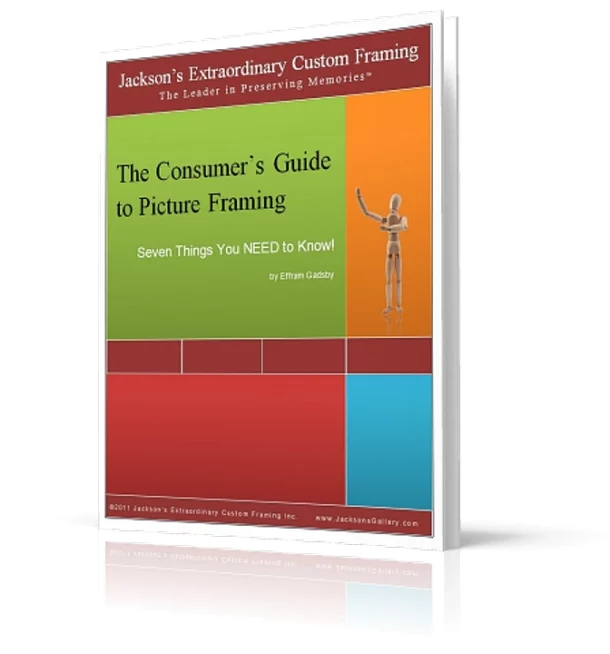How To Choose the Right Picture Frame

![]() G etting the right picture frame is vital to the overall success of your custom framing piece, but with 1000’s of styles and a range of materials to choose from, how do you make the right choice?
G etting the right picture frame is vital to the overall success of your custom framing piece, but with 1000’s of styles and a range of materials to choose from, how do you make the right choice?
Essentially, choosing framing is a process of elimination. It’s overwhelming to see a wall of picture frames (at Jackson’s we currently have over 2200 frames on our wall), so we want to cull the herd and cross off the ones that won’t work.
The first step is the obvious one of identifying whether it’s a flat object (art, photograph, etc.), or 3D (grandpa’s pipe and glasses, Rover’s favourite chew toy, etc.) This will help to narrow your choices off the bat, as some frames are better suited to one or the other.
Next is to identify the ‘tone’ of the object being framed. What theme does it portray? Is it vintage or modern? Is it Western? Asian? Native American? European? This will again help to eliminate all of the frames meant for specific, yet different themes.
Now let’s look at colour, this will also eliminate a large number of frames from contention: if they’re obviously unsuitable, take them out of the running. Remember you don’t need to match the colours of the object, you need to compliment them.
Sometimes the room the object will be hung in will influence your decisions. While we always need to keep our focus on making the object look its best, this is also the Real World and the wall it’s being hung in can matter as to which of our narrowed-down choices we make.
Once we get a better idea of which direction to go, we have to look at the ‘beefiness’ of the frame. Several framing lines come in varying thicknesses, from quite slim to mammoth-sized and the overall dimensions of the piece dictates which end of the spectrum you’ll look at. This means getting an idea of how big the piece will be once it’s on the wall, including much matting to show, if any, as having three inches of matting versus 5 inches can change which size and heft of frame look best.
Other things being equal, bigger pieces need the structural support of a bigger frame.
And yes, thicker frames cost more money, but be careful of making a ‘false economy’ by skimping on frame thickness; a thin frame can throw the balance and visual impact for a loop.
Rather like a big man wearing a too-small kilt, if you get me … 🙂
If you haven’t yet, be sure you download a free copy of “The Consumer’s Guide to Picture Framing – 7 Things You NEED to Know!”
Scroll Down and Leave a Comment!




These tips make a lot of sense! I’m very picky about my frames to begin with, so I’ll keep all this in mind!
I recently moved into my first home and I am very excited. The apartment I had been living in for 7 years didn’t allow us (me or my husband) to hang anything on the walls so it was very plain in there. Now that we have our own space, I am trying to decide on framed artwork and I had no idea there were so many frame options! This article was very helpful, just wanted to say thank you!
Thanks Brie! Glad it was helpful!
The wife is insisting that we go with lighter colored framing that is thinner for our art pieces. We have a neutral living area with white walls. I don’t think it will look too good. I am going to share this with her, see if it can change her mind.
Good luck! 🙂
Thanks for pointing out that you must choose a picture frame that compliments the color of the photo that is being framed. I am planning our new family portraits framed before our reunion party on the 25th.
Do oversized wall canvas prints distort the printed art and make the art look cheap? I’m looking for a dramatic look in my dining room. Looking at art 72 x36
Hey Iiene! Size by itself doesn’t say much: it’s mostly a factor of resolution. If the resolution is high enough, a large piece can looking stunning! IF not, even an 8’x10″ can look junky (think of how the old 35mm camera prints looked blown up).
Modern tech allows for some dashed awesome images, and 3’x6′ feet isn’t that big anymore, they go by pixels instead of inches or cm.
The other factor is “dots per inch”, or DPI. For printing you really need 300dpi.
For the size you’re looking for, you’ll need it to be 10800×21600 pixels at 300dpi. Anyplace you buy from should be able to tell you if that’s what it is.
Ultimately, the answer is “look and see”, but I hope this helps!